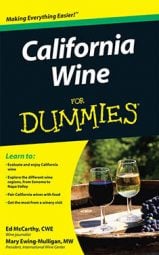Because of the popularity of White Zinfandel and other California blush (pink and sweet) wines, California’s rosé wines have had a reputation for being sweet and innocuous. That reputation is changing, as more and more California dry rosés become available, and they're in demand.
Of course, California still makes plenty of White Zinfandel and other sweet rosés. These wines are inexpensive, easy-drinking, flavorful, and no, not serious. But there’s definitely a time and a place to enjoy wines that don’t take themselves too seriously — and there’s certainly a place for any wine that has as many fans as White Zinfandel does.
The term blush wine, which came into vogue in the U.S. in the 1970s, is a general name for any sweet pink wine. White Zinfandel’s success has given rise to many other blush wines in California, such as Cabernet Blush, or White Cabernet; White Merlot; and Grenache Rosé, or White Grenache. All blush wines are fairly similar in style.
Serious, dry rosés
Serious California rosés include all rosé wines made in a dryer style. They retail for over $10, generally in the $12 to $20 range — as opposed to sweeter rosés and blush wines, which are almost always under $10. They can come from any red grape variety, and they might or might not be labeled with the name of the grape. The varieties most frequently used for California rosés are Pinot Noir, Sangiovese, Grenache, and Syrah (the last two often blended together).
Two French terms you sometimes see on California rosé labels are oeil de perdrix (meaning “eye of the partridge”) and vin gris (“gray wine”), both referring to color. These terms usually apply to very pale rosé wines that are often dryer than deeper-colored rosés.
White Zinfandel
White Zinfandel isn’t selling at the same frenzied pace that it did in the 1980s and 1990s, but it’s still the third best-selling varietal wine in California, just slightly behind Cabernet Sauvignon and well behind Chardonnay. Winemakers produce White Zinfandel by draining the grape juice from the dark skins before the juice has had the chance to absorb more than a pale pink color.
Although wine connoisseurs scorn White Zinfandel as something more akin to a beverage than a real wine, it’s certainly special to the many thousands who drink it. The wine offers sweetness, fruitiness, moderate alcohol levels, and no tannin, for a mild-tasting wine that doesn’t bite. White Zinfandel is the perfect wine for you if you find most wines too dry or astringent.
White Zinfandel’s color ranges from pale pink to a dark rose, and depending on the producer, the wine can vary in sweetness from off-dry to quite sweet. As a general rule, paler White Zins tend to be less sweet, and very pink ones tend to be sweeter. Regardless of hue, they’re always soft in texture and low in alcohol. White Zinfandel is a wine to drink cold, and it’s a wine to drink while it’s young and fresh; buy the most recent vintage you can find, and chill it.

